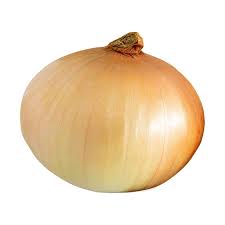 An onion also known as the bulb onion or common onion, is a vegetable that is the most widely cultivated species of the genus Allium.
An onion also known as the bulb onion or common onion, is a vegetable that is the most widely cultivated species of the genus Allium.
The shallot is a botanical variety of the onion.
The onion’s close relatives include garlic, scallion, leek, and chives.
The onion is most frequently a biennial or a perennial plant, but is usually treated as an annual and harvested in its first growing season.
The bulbs are composed of shortened, underground stems surrounded by fleshy modified leaves that envelop a central bud at the tip of the stem.
As a food item, they are often served raw as a vegetable or part of a prepared savoury dish, but can be eaten cooked or used to make pickles or chutneys.
They are pungent when chopped and contain certain chemical substances which may irritate the eyes.
Modern varieties typically grow to a height of 6 to 18 in.
As the onion matures, food reserves accumulate in the leaf bases, and the bulb of the onion swells.
Three color varieties of onions offer different possibilities for the cook:
Yellow or brown onions are sweet, with many cultivars bred specifically to accentuate this sweetness, such as Vidalia, Walla Walla, Cévennes, and Bermuda.
Red or purple onions, known for their sharp pungent flavour, are commonly cooked in many cuisines, and used raw and in grilling.
White onions are mild in flavour; they have a golden color when cooked and a particularly sweet flavour when sautéed.
The mature onion bulb is most often eaten, onions can be eaten at immature stages.
Young plants may be harvested before bulbing-spring onions or scallions.
When an onion is harvested after bulbing has begun, but the onion is not yet mature, the plants are sometimes referred to as “summer” onions.
Onions may be bred and grown to mature at smaller sizes, known as pearl, boiler, or pickler onions; these are not true pearl onions which are a different species.
Onions are commonly chopped and used as an ingredient in various hearty warm dishes, and can be baked, boiled, braised, grilled, fried, roasted, sautéed, or eaten raw in salads.
Raw onion bulbs; Nutritional value per 100 g (3.5 oz)
Energy 166 kJ (40 kcal)
Carbohydrates 9.34 g
Sugars 4.24 g
Dietary fiber 1.7 g
Fat 0.1 g
Protein 1.1 g
Water 89.11 g
Fluoride 1.1 µg
Onions contribute savoury flavour to dishes without contributing significant caloric content.
Onion varieties vary widely in phytochemical content, particularly for polyphenols, with shallots having the highest level, six times the amount found in Vidalia onions.
Yellow onions have the highest total flavonoid content, an amount 11 times higher than in white onions.
Red onions have considerable content of anthocyanin pigments, with at least 25 different compounds identified representing 10% of total flavonoid content.
Like garlic, onions can show an additional colour – pink-red – after cutting, an effect caused by reactions of amino acids with sulfur compounds.
Some people suffer from allergic reactions after handling onions: contact dermatitis, intense itching, rhinoconjunctivitis, blurred vision, bronchial asthma, sweating, and anaphylaxis.
Allergic reactions may not occur when eating cooked onions, possibly due to the denaturing of the proteins from cooking.
Freshly cut onions can produce a stinging sensation in the eyes and often uncontrollable tears, caused by the release of a volatile liquid, syn-propanethial-S-oxide and its aerosol, which stimulates nerves in the eye.
Chopping an onion causes damage to cells which releases enzymes called alliinases that break down amino acid sulfoxides and generate sulfenic acids.
This gas diffuses through the air and soon reaches the eyes, where it activates sensory neurons.
Lacrimal glands produce tears to dilute and flush out the irritant.
Eye irritation can be minimized by cutting onions under running water or submerged in a basin of water.
Leaving the root end intact also reduces irritation as the onion base has a higher concentration of sulphur compounds than the rest of the bulb.
Cut onions emit a chemical gas compound which cause the lacrimal glands in the eyes to become irritated, releasing tears.
The amount of sulfenic acids and lacrimal factor released and the irritation effect differs among Allium species.
Gas chromatography is also used to measure lachrymatory factor in onions.
Onions are toxic to animals including dogs, cats, and guinea pigs.
Onions are a widely cultivated vegetable crop, produced in the second largest quantity after tomatoes.
In the home, cooking onions and sweet onions are best stored at room temperature, In this environment, cooking onions have a shelf life of three to four weeks and sweet onions one to two weeks.
Cooking onions will absorb odours from apples and pears.
Sweet onions have a greater water and sugar content than cooking onions, making them sweeter and milder tasting, but reduces their shelf life.
Sweet onions can be stored refrigerated; they have a shelf life of around one month. Irrespective of type, any cut pieces of onion are best tightly wrapped, stored away from other produce, and used within two to three days.
